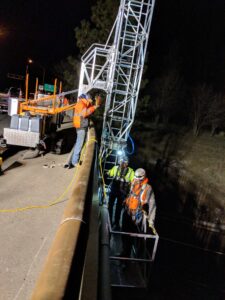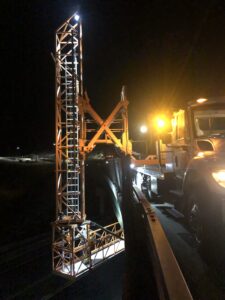Those who work in the transportation infrastructure field carry out a wide variety of tasks. And, for some, inspecting highway bridges is a fairly routine job depending on where they’re located and the number of bridges in their region.
In this article, we want to take a brief look at how these routine bridge inspections help maintain and protect America’s transportation infrastructure.
Keeping America Moving Safely and Efficiently
As transportation infrastructure continues to be a critical component of our daily lives, it is essential to understand how to ensure its safety and reliability.
For our purposes here, the transportation infrastructure refers to the framework that supports various transport systems. Prior to the 1830s, most all transportation in the U.S. was limited to roads and shipping lanes. With the advent of the commercial railway industry, that began to change.
And, today, It consists of fixed installations that include roads and railways, as well as airways, waterways, canals, and pipelines and terminals such as airports, railway stations, bus stations, warehouses, trucking terminals.
All of this “infrastructure” – the roads, railways, bridges, etc. – must also be maintained, repaired, periodically rehabilitated, and even replaced. And this requires a great deal of work and funding year-round, but it also provides tens of thousands of jobs.
According to the World Bank, roads, for example, are considered to be “among the most important public assets in any country.” Consequently, keeping them in good working condition is critical.
In addition to repairs and mechanical maintenance, there are various roadway and bridge maintenance pollution prevention practices that can reduce “pollutant loadings” on existing road surfaces. These practices include routine maintenance activities such as vegetation maintenance, sweeping, and cleaning stormwater discharge control structures.
Other routine roadway maintenance activities may include re-graveling unpaved roads, resealing paved roads, and re-graveling of shoulders.
Highway Bridges and Transportation System Safety
Our bridges are structures that are ostensibly built to last a “lifetime” and we drive or ride over them usually without much thought to their integrity and condition. However, bridges age with time, and not all are in pristine condition.
In fact, according to the American Road & Transportation Builders Association (ARTBA), of the country’s 618,422 bridges, there are 45,023, or approximately 7.3 percent, that are rated “structurally deficient” and considered to be in poor or worse condition. And it is estimated that motorists cross these less-than-sound structures approximately 171.5 million times every day.
Because highway bridges can be viewed as the potential “weak links” in a roadway system, particular care is given to maintaining the soundness and structural integrity of our nation’s more than 600,000 bridges.
And one of the primary means of doing so involves inspections.
Bridge inspections are vitally important for identifying potential safety issues and for recognizing problems before they become major issues. By conducting regular, or routine, inspections, bridges can be reliably maintained and kept in good condition, which allows for safe and reliable transportation.
These federally mandated routine bridge inspections are also critical for ensuring the safety of the transportation infrastructure in the United States. Most bridge inspections focus on critical structural components of bridges, such as those that could lead to significant property damage, and even the collapse of a bridge, resulting in injuries and deaths.
The Benefits of Bridge Inspections: Keeping Transportation Infrastructure Safe and Efficient
As we’ve pointed out here, highway bridge inspections are an integral part of maintaining and protecting our transportation infrastructure and are beneficial for ensuring that bridges remain in safe and efficient conditions for both traffic and pedestrians.
Some of the benefits of bridge inspections include:
- Ensuring Safety: Routine bridge inspections ensure the safety of the traveling public. Because bridges are crucial components of the transportation network, their failure can cause catastrophic consequences. With regular inspections, agencies can identify any structural deficiencies and ensure that repairs are made before they become critical.
- Preventive Maintenance: Routine inspections help identify minor issues and enable repairs to be made before these become major problems. This proactive approach to maintenance can save significant costs over time by preventing larger and more expensive repairs.
- Maximizing Lifespan: Regular inspections and maintenance can help prolong the lifespan of bridges, saving significant costs on replacements, and allow structural engineers to take needed steps to extend the life of the bridge and ensure that it remains safe for use.
- Improved Efficiency: Bridges that are well-maintained and safe to use can improve transportation efficiency. Bridges that are repeatedly closed for major repairs or emergency maintenance, however, can cause significant and unnecessary disruptions to traffic flow, leading to congestion and delays.
- Compliance with Regulations: The Federal Highway Administration (FHWA) requires all highway bridges in the United States to undergo regular inspections to ensure they meet minimum safety standards. Regular inspections ensure that highway bridges are in compliance with these regulations, improving safety while reducing liability risks.
In summary, it is safe to conclude that our routine highway bridge inspections play an essential and critical role in ensuring the safety and efficiency of the nation’s transportation infrastructure.
Under Bridge Platforms: Your Source for Under Bridge Inspection Equipment
With the wide range of capabilities available in under bridge inspection equipment, determining which unit to rent for your bridge inspection project can be challenging at times. However, the size and type of equipment needed often depends on the bridge structure itself and the terrain underneath.
Cost is a major consideration, of course, but your specific project needs and the reach and other capabilities required should be the primary deciding factors for your under bridge inspection truck choice.
As professionals in the industry, Under Bridge Platforms is fully capable of guiding you through the process of renting or buying the right vehicle and equipment for your project. Our combined years of experience and knowledge are key to helping you make the best choice.

We provide quality under bridge equipment throughout all the Western States, including California, Washington, and Oregon. Our inventory of snooper trucks and under bridge access platforms include the Barin Automatic Bridge Control ABC 50/C, as well as Truck-Mounted Hydra Platform HPT43, a state-of-the-art self-driving access platform.

We are proud to be the only company in California that offers total under bridge access. By offering high quality customer service, we have managed to build long-lasting relationships with our esteemed customers.
And we intend to keep it that way.
So, contact us today to discuss your requirements at 707-528-0373 or email us at info@underbridgeplatforms.com.

Recent Comments